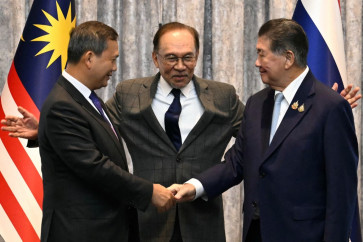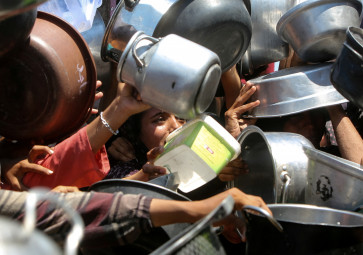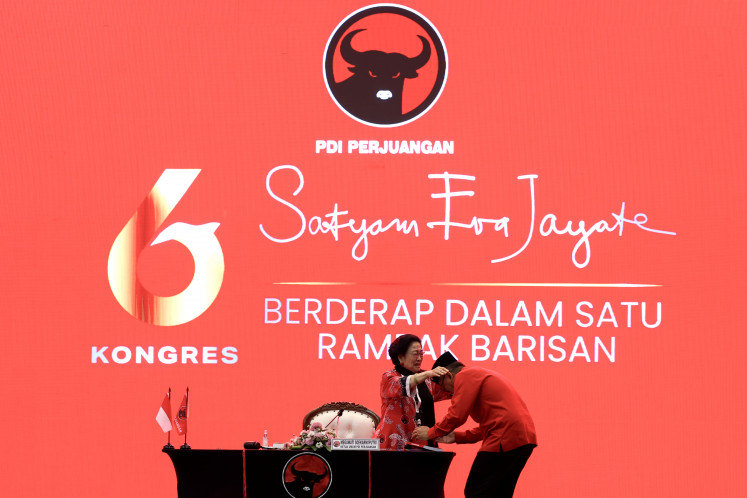Popular Reads
Top Results
Can't find what you're looking for?
View all search resultsPopular Reads
Top Results
Can't find what you're looking for?
View all search resultsEnergy subsidies in the 2012 State Budget plan
The government has once again promised to allocate a budget subsidy of a quite fantastic amount
Change text size
Gift Premium Articles
to Anyone
T
he government has once again promised to allocate a budget subsidy of a quite fantastic amount. But such a huge budget will mean nothing if it cannot be fully enjoyed by low-income people. In reality, what tends to happen is the subsidy that’s intended for the poor is mostly enjoyed by the middle to upper classes of society. It’s an irony!
In his annual state address on the 2012 State Budget Plan (RAPBN), and its Financial Notes on Aug. 16, 2011, President Susilo Bambang Yudhoyono implied that the budget subsidy might reach Rp 208.9 trillion (US$24.4 billion). Such a huge allocation, isn’t it? And yet the President said that amount is lower than the subsidy offered in the 2011 Revised State Budget, which amounts to Rp 237.2 trillion.
Despite the fact that the amount of the 2012 budget subsidy is less than that in the 2011 revised budget by Rp 28.3 trillion, it is still too large a burden on the budget, especially if it is absorbed for a misdirected and mismanaged subsidy.
It can also be compared to allocations from the budget for expenditure on infrastructure development, which is lower than the expenditure for civil servants.
In the RAPBN 2012, allocation for infrastructure will be only Rp 168.1 trillion, while expenditure for civil servants will amount to Rp 215.72 trillion. According to a government statement, the huge subsidy will be distributed between three sectors: a subsidy on fuel oil that will total Rp 123.6 trillion; another for electricity amounting to Rp 45 trillion; and a non-energy subsidy of Rp 40.3 trillion.
The non-energy component consists of subsidies on food, fertilizers, seeds, public service obligations, program loan interest and taxation.
Considered as a strategic budget, can we be optimistic that these budget allocations will improve people’s welfare? Indeed, there could be a sarcastic response that the government’s budget plan in 2012 is not down-to-earth and such a big budget will be wasted.
We should remember, however, that these figures, specifically the energy subsidies listed in the RAPBN 2012, are merely indicators. In reality, there is the possibility that the figures will change in the course of further deliberations by the legislature. People should not be defrauded.
With a relatively high amount of subsidy for energy, we have to find alternate ways to cut the subsidy gradually and in a well-planned fashion — especially the subsidy for oil, which absorbs a high proportion of the budget. The oil subsidy must be relocated to encourage the development of sustainable energy sources while, at the same time, reducing our dependence on oil for fuel, as natural supplies will necessarily decrease over time.
We agree that the problem we are facing now is mismanagement of subsidized oil. Therefore, the House of Representatives has urged the government to be more courageous and take strategic measures to change its scheme of price subsidies into direct subsidies.
People, especially those on low incomes, who do not consume subsidized fuel have the right to better public facilities, such as safe and convenient modes of mass transportation. This is something that has not been fulfilled by the government.
If the subsidy is looked at merely in terms of price, then we can see a big price disparity between subsidized and non-subsidized fuels. As a result, illegal practices are rife, such as stockpiling and manipulation regarding the use of subsidized oil fuel, which ultimately causes fuel shortages. These have to be anticipated by the government in order to avoid a domino effect.
However, under current circumstances, where the burden of subsidies on the budget is quite high and global economic fluctuations are, among other things, being caused by sudden increases in the world oil prices, the government must have the courage to implement unpopular policies.
One option is to gradually increase the subsidized oil price or to control the volume of subsidized fuel via a strict monitoring mechanism, which could be used efficiently, effectively and reach the target.
One thing that may well prevent subsidized oil from surpassing its targets is the massive development of alternative fuel sources; changing, for instance, from the use of oil to gas. But this will not run without hindrance. One important factor in the development of alternative fuel is the current lack of infrastructure support. This is much needed “homework” for the government.
Monitoring must also be improved with regards to leaks from the state budget in relation to the fuel subsidy. Lawmakers, in terms of volume, have approved additional quotas of subsidized fuel and the government has to ensure that the total volume of oil reaches consumers and at the predetermined price.
There should be no stockpiling practices that may cause fuel scarcities, which would spark a hike in prices. That would be harmful to the people.
The option to raise the subsidized fuel price or control its volume must be carefully considered by the government in order to ensure such moves do not spark social and economic unrest. If the government opts for a price increase on premium and diesel oils, an extensive familiarization program will be very important to offer people a good understanding.
Without a price increase, the oil fuel quota will continue to surpass targets and, as a consequence, subsidy allocations will continue to increase. Raising the subsidized oil price — on the condition that the government puts forward a reasonable argument — may be accepted by the people without objection.
And if the government opts to control subsidized fuel consumption, it must be ascertained whether supplies can be distributed under strict supervision. Law enforcement thus becomes an important issue, as there might be traders who commit stockpiling practices in order to make as much profit as they can.
We have reminded the government not to impose a policy to raise the price of subsidized fuel at the same time as increasing by 10 percent the basic tariff of electricity. These two issues are sensitive for people.
Therefore, The House of Representatives has advised the government to implement a policy on subsidized fuel oil only after full and mature consideration, so as to create tranquility and to avoid unrest that could disturb national stability.
The writer is a member of the Golkar Party and serves on House of Representatives’ Commission VII overseeing technology.










